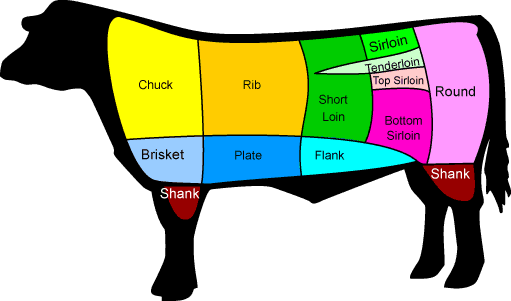
GUIDE TO AMERICAN PRIME CUTS
Know Your Cuts
The following is a list of the American primal cuts. Beef are split along the axis of symmetry into “halves”, then across into front and back “quarters” (forequarters and hindquarters).
Click on each section of the image below to learn more about the cut.



The chuck is the source of bone-in chuck steaks and roasts (arm or blade), and boneless clod steaks and roasts, most commonly. The trimmings and some whole boneless chucks are ground for hamburgers.

The rib contains part of the short ribs, the prime rib and rib eye steaks.

In Asia, brisket is used primarily for stews (e.g., five-spice beef, curry beef brisket;) while Westerners tend to use it for barbecue, corned beef or pastrami.

The foreshank or shank is used primarily for stews and soups; it is not usually served any other way due to it being the toughest of the cuts.

The flank is used mostly for grinding, except for the long and flat flank steak, best known for use in London broil, and the inside skirt steak, also used for fajitas.

The flank is used mostly for grinding, except for the long and flat flank steak, best known for use in London broil, and the inside skirt steak, also used for fajitas.

The loin has two subprimals, or three if boneless: 1. Short loin, from which the T-bone and Porterhouse steaks are cut if bone-in, or strip steak (Kansas City strip) is cut if boneless

2. The sirloin, which is less tender than short loin, but more flavorful, can be further divided into top sirloin and bottom sirloin (including tri-tip), and

3. The tenderloin, which is the most tender can be removed as a separate subprimal, and cut into filet mignons, tournedos or tenderloin steaks, and roasts (such as for beef Wellington). They can also be cut bone-in to make parts of the T-bone and Porterhouse loin steaks.

The round contains lean, moderately tough, lower fat (less marbling) cuts, which require moist cooking or lesser degrees of doneness. Some representative cuts are round steak, eye of round, top round and bottom round steaks and roasts.

The chuck is the source of bone-in chuck steaks and roasts (arm or blade), and boneless clod steaks and roasts, most commonly. The trimmings and some whole boneless chucks are ground for hamburgers.

The rib contains part of the short ribs, the prime rib and rib eye steaks.

In Asia, brisket is used primarily for stews (e.g., five-spice beef, curry beef brisket;) while Westerners tend to use it for barbecue, corned beef or pastrami.

The foreshank or shank is used primarily for stews and soups; it is not usually served any other way due to it being the toughest of the cuts.

The flank is used mostly for grinding, except for the long and flat flank steak, best known for use in London broil, and the inside skirt steak, also used for fajitas.

The flank is used mostly for grinding, except for the long and flat flank steak, best known for use in London broil, and the inside skirt steak, also used for fajitas.

The loin has two subprimals, or three if boneless: 1. Short loin, from which the T-bone and Porterhouse steaks are cut if bone-in, or strip steak (Kansas City strip) is cut if boneless

2. The sirloin, which is less tender than short loin, but more flavorful, can be further divided into top sirloin and bottom sirloin (including tri-tip), and

3. The tenderloin, which is the most tender can be removed as a separate subprimal, and cut into filet mignons, tournedos or tenderloin steaks, and roasts (such as for beef Wellington). They can also be cut bone-in to make parts of the T-bone and Porterhouse loin steaks.

The round contains lean, moderately tough, lower fat (less marbling) cuts, which require moist cooking or lesser degrees of doneness. Some representative cuts are round steak, eye of round, top round and bottom round steaks and roasts.

The round contains lean, moderately tough, lower fat (less marbling) cuts, which require moist cooking or lesser degrees of doneness. Some representative cuts are round steak, eye of round, top round and bottom round steaks and roasts.
Learn About USDA Grades for Meat
Beef Quality is graded for tenderness, juiciness, and flavor
Prime grade is produced from young, well-fed beef cattle. It has abundant marbling and is generally sold in restaurants and hotels. Prime roasts and steaks are excellent for dry-heat cooking (broiling, roasting, or grilling).
Choice grade is high quality, but has less marbling than Prime. Choice roasts and steaks from the loin and rib will be very tender, juicy, and flavorful and are, like Prime, suited to dry-heat cooking. Many of the less tender cuts, such as those from the rump, round, and blade chuck, can also be cooked with dry heat if not overcooked. Such cuts will be most tender if “braised” — roasted, or simmered with a small amount of liquid in a tightly covered pan.
Select grade is very uniform in quality and normally leaner than the higher grades. It is fairly tender, but, because it has less marbling, it may lack some of the juiciness and flavor of the higher grades. Only the tender cuts (loin, rib, sirloin) should be cooked with dry heat. Other cuts should be marinated before cooking or braised to obtain maximum tenderness and flavor.

